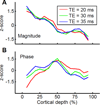Identification of cortical lamination in awake monkeys by high resolution magnetic resonance imaging
- PMID: 22080152
- PMCID: PMC3288753
- DOI: 10.1016/j.neuroimage.2011.10.079
Identification of cortical lamination in awake monkeys by high resolution magnetic resonance imaging
Abstract
Brodmann divided the neocortex into 47 different cortical areas based on histological differences in laminar myeloarchitectonic and cytoarchitectonic defined structure. The ability to do so in vivo with anatomical magnetic resonance (MR) methods in awake subjects would be extremely advantageous for many functional studies. However, due to the limitations of spatial resolution and contrast, this has been difficult to achieve in awake subjects. Here, we report that by using a combination of MR microscopy and novel contrast effects, cortical layers can be delineated in the visual cortex of awake subjects (nonhuman primates) at 4.7 T. We obtained data from 30-min acquisitions at voxel size of 62.5 × 62.5 × 1000 μm(3) (4 nl). Both the phase and magnitude components of the T(2)*-weighted image were used to generate laminar profiles which are believed to reflect variations in myelin and local cell density content across cortical depth. Based on this, we were able to identify six layers characteristic of the striate cortex (V1). These were the stripe of Kaes-Bechterew (in layer II/III), the stripe of Gennari (in layer IV), the inner band of Baillarger (in layer V), as well as three sub-layers within layer IV (IVa, IVb, and IVc). Furthermore, we found that the laminar structure of two extrastriate visual cortex (V2, V4) can also be detected. Following the tradition of Brodmann, this significant improvement in cortical laminar visualization should make it possible to discriminate cortical regions in awake subjects corresponding to differences in myeloarchitecture and cytoarchitecture.
Copyright © 2011 Elsevier Inc. All rights reserved.
Figures








References
-
- Abduljalil AM, Schmalbrock P, Novak V, Chakeres DW. Enhanced gray and white matter contrast of phase susceptibility-weighted images in ultra-high-field magnetic resonance imaging. J Magn Reson Imaging. 2003;18:284–290. - PubMed
-
- Baillarger JGF. Recherches sur la structure de la couche corticale des circonvolutions du cerveau. Mem. Acad. R. Med. 1840;8:149–183.
-
- Barbier EL, Marrett S, Danek A, Vortmeyer A, van Gelderen P, Duyn J, Bandettini P, Grafman J, Koretsky AP. Imaging cortical anatomy by high-resolution MR at 3.0T: detection of the stripe of Gennari in visual area 17. Magn Reson Med. 2002;48:735–738. - PubMed
-
- Bechterew W. Zur Frage uber die ausseren Associationsfasern der Hirnrinde. Neurol Zentrbl. 1891;10:682–684.
-
- Benveniste H, Blackband S. MR microscopy and high resolution small animal MRI: applications in neuroscience research. Prog Neurobiol. 2002;67:393–420. - PubMed
Publication types
MeSH terms
Grants and funding
LinkOut - more resources
Full Text Sources
Medical

